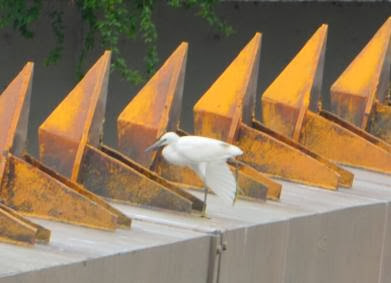However, there was not really enough time that day to make a specific trip to anywhere new, and I was coming down with a cold. Other than a flock of about 10 unidentifiable larks or pipits at the Beijing airport, I only saw feral "Rock" Pigeons and magpies on the day, near the street where our hotel was located.
Far from being "just a city bird" for me, though, the semi-familiar species of true magpie present in eastern China is an interesting subject. Here I'll expand a bit on that.
Generally, perhaps even stereotypically, there are different schools of thought about magpie classification. Traditionally, all "true magpies" in the genus Pica were lumped under one Holarctic umbrella as the species Pica pica, the familiar Common (or Eurasian) Magpie of Europe. However, North American taxa have usually been split by North American authorities in recent years - these two would be Black-billed Magpie (Pica hudsonia) and Yellow-billed Magpie (Pica nuttalli), the latter a species endemic to California that was isolated in, and began to diverge during, glacial times.
Given that Common, Black-billed, and Yellow-billed Magpies are fairly sedentary and live completely isolated from each other, it seems straightforward to split these dissimilar taxa. But the remaining "Common Magpie" complex itself, as usually defined, has a vast range and multiple (sub)clades (and traditional subspecies). Since these often-lumped taxa are different enough to warrant historically subspecific status, is it possible the birds in these populations are actually specifically distinct?
As it turns out, the magpies in Beijing are part of the most commonly split group, specifically being in the traditionally-retained subspecies Pica pica sericea. When considered a full species (along with two or three other subspecies under Pica pica), these magpies in China become Pica sericea, called Korean, Oriental, or Eastern Magpie. You will find this proposed taxon referred to as Korean Magpie, for instance by Wikipedia and any sites that are based off of it, but I personally disfavor this name as it is geographically misleading (and it's not an inevitable name for this often-unsplit taxon). Whatever you call it, these magpies are found throughout continental east-central Asia, including an introduced population in southern Japan.
Pica [pica] sericea is generally considered basal within Pica, and is the largest true magpie. Though some authorities already split it from Common, the "Oriental" Magpie (comprising two or three races traditionally considered subspecies of Common) is generally provisionally retained within Common at best. It is my opinion that given any further in-depth work on Pica, either Oriental Magpie must be split or all current species must be reconsidered; I of course hope that Oriental Magpie will be recognized as separate, but it remains to be seen if that's completely accurate.
What then is goin' on with the rest of the world's Pica spp.? All the rest of the divergence, including between currently recognized P. pica, P. hudsonia, and P. nuttalli, happened more recently than between the ancestor of those species and the ancestor of P. [pica] sericea. (You can begin to see why even my relatively casual reading of the literature leads me to think Oriental Magpies merit specific status.)
Lee et al argued in 2003 that "[c]urrently, we do not have reliable evidence of either reproductive isolation or hybridization between New World and Old World magpies, or between the two New World magpies", noting that there may have been a small amount of gene flow across the Bering land bridge and that we do not know if the differing behavior and morphologies of pica, hudsonia and nuttalli already served as barriers to interbreeding. The ranges of the three taxa don't overlap today, so obviously there is no way to see if morphology and behavior are barriers to interbreeding in the wild.
But I would argue - again, not as a scholar of Pica, but just from reading - that it's disingenuous to suggest there isn't reproductive isolation. The simple fact of the three currently-recognized magpie species' distributions being entirely separate is a present-day reproductive barrier, regardless of other features. Differences in morphology and behavior already exist, and will likely persist in the isolated taxa as long as they do survive. Taking the long view of their isolation from each other, one must ask: if these magpies are not separate species now, when will they be?
For the purposes of this blog and throughout my travels, I consider Pica to contain at least four species: Oriental Magpie (Pica sericea), Common Magpie (Pica pica), Black-billed Magpie (Pica hudsonia), and Yellow-billed Magpie (Pica nuttalli). I await any more definitive taxonomic decision on these taxa. So if you're reading this and something more recent has come out, let me know!
Next time we'll be back to birding site-by-site in Beijing, where many more species await.
(Here are a couple of articles I found helpful when writing this post.)
Lee, S. I., C. S. Parr, Y. Hwang, D. P. Mindell, and J. C. Choe. "Phylogeny of magpies (genus Pica) inferred from mtDNA data." Molecular phylogenetics and evolution 29, no. 2 (2003): 250.
Haring, E., Gamauf, A., & Kryukov, A. (2007). "Phylogeographic patterns in widespread corvid birds." Molecular phylogenetics and evolution, 45(3), 840-862.





















